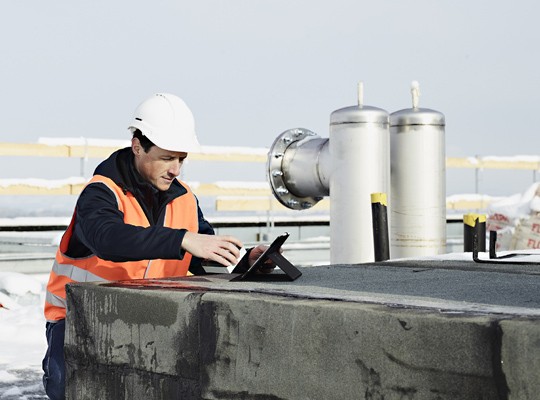Internet of Things for smart buildings
Flat roof that finds holes on its own
The IoT-based solution Orkanet from siworks monitors flat roofs and triggers an alarm when it finds a leak. Project manager Jonas Uebelhart believes that smart flat roofs are just the beginning for smart buildings.
Text: Jörg Rothweiler, Images: Herbert Zimmermann, Video: TinCan Motion, 16 may 2019
Jonas Uebelhart is no digital nerd, but he does appreciate what digitalisation is making possible and is putting specific applications to good use – to the benefit of customers and business performance. An architectural draughtsman by training, Uebelhart completed secondary school in Horw, Switzerland, before going on to earn his Bachelor of Science in industrial engineering and innovation with a focus on IoT-based building sensor systems.
Smart cars, dumb homes
‘Today, cars are smarter than buildings,’ he says. ‘Even compact cars have numerous sensors that monitor countless parameters and trigger alarms if there is a risk of technical damage or threat to operational safety, for example, when a tyre is losing pressure. Buildings, on the other hand, have been a black hole of sorts. We have no insights into their interior structure and know almost nothing about the state of a building. This is why damage is usually only discovered when something becomes conspicuous – and that’s when things get expensive,’ says Jonas Uebelhart, who joined the building sensor specialists at siworks as a Project Manager in 2016 after completing his studies. He is in charge of Orkanet, the company’s smart flat roof monitoring system.
Customer requests and initiative
Orkanet grew out of a customer need. ‘In 2015, we had a customer who was looking for a system to constantly monitor the state of his properties,’ Jonas Uebelhart tells us. ‘Because there was no such solution available, siworks began developing one itself. It worked but had to be connected with wiring and was cumbersome to install.’ Jonas Uebelhart knew there had to be a better way. In late 2016, when he found out about the Low Power Network, Swisscom’s LoRaWAN-based network for the Internet of Things, he was thrilled. Then in early 2017, he and his Orkanet team colleagues took part in the IoT boot camp. After that they hardly had a moment to catch their breath, he says. Working with a Swiss specialist, they developed new IoT sensors and a web application to show users the measured values at all times and manage their projects. In the early summer of 2018, Orkanet was ready for series production. Since then, several dozen systems have been installed across the country – including the tallest wooden building in Switzerland, located at the west end of the Suurstoffi site in Rotkreuz.

Jonas Uebelhart: ‘Constant analysis of the building structure will help us to better understand the flat roof “system”.’
No power or internet connection required
The first part of Orkanet is a closed-loop cable run along the edge of the roof along with another cable that snakes through the roof construction. If water penetrates into the roof, power will flow between these two potential cables – triggering an alarm. The second part of the system is made up of sensor boxes placed in roof punch-throughs that resemble chimneys on the roof surface. These sensors constantly monitor temperature, moisture and water levels and transmit the values to the system via the Swisscom LPM (Low Power Network) – autonomously and without power or internet connections. If a value exceeds or falls below a certain threshold, the system triggers an alarm, allowing the owner or roofer to respond quickly and appropriately. ‘They know what the problem is and can narrow down the location so that they can fix it quickly – before the insulation or ceiling structure gets soaked,’ says Jonas Uebelhart. ‘That saves money and protects the environment, because wet insulation sometimes has to be disposed of as hazardous waste.’

Uebelhart performs a system check via the web portal.
Continuously improving flat roof construction
In addition to the obvious advantages for property owners, Orkanet also has considerable potential in improving the construction of flat roofs. ‘The constant analysis of the state of the building structure will help us to better understand the flat roof “system”. In the long term, we hope to find new methods for predictive maintenance as well as valuable information on developing optimised roof designs and innovative building materials,’ says Jonas Uebelhart.
And in the foreseeable future, some IoT building sensors that have already been developed, such as those that monitor indoor climate, will continue to provide more detailed insights into the structure and shell of buildings. ‘In a few years, homes will be just as “smart” as cars. This will help produce better and better products and offer data-driven service and maintenance as well as the ability to plan ahead,’ says Jonas Uebelhart.

The sensor boxes constantly monitor temperature, moisture and water levels.
Orkanet IoT-based flat roof monitoring system
- Active IoT solution for constant and redundant monitoring of flat roofs and rooftop terraces using a comprehensive and selective measurement procedure.
- Orkanet Light upgrade option for existing flat roofs
- Secure communication and data transmission via the Low Power Network in combination with the Connectivity Management Platform from the Swisscom Enterprise IoT portfolio.
- Battery life up to five years; easy-to-change battery
- Constant data transmission and analysis
- Web application with user-friendly dashboard
Siworks AG
- Founded: 2010
- Company size: 21 employees
- Structure: Public limited company (AG) made up of three companies: siworks AG, siworks products GmbH and siworks immo AG
- Products: Engineering services, fire protection systems and building sensor systems; property development, seminars and digitalisation in construction; production of electromechanical components and devices, logistics
Swisscom Indoor Connectivity
Networking devices inside buildings is no easy undertaking: thick walls, materials with shielding properties, such as concrete and steel, and areas deep underground impede the transmission of radio signals. While closed systems can help, devices made by other IoT providers are difficult to integrate into the network. Added to this, it is not always possible to guarantee a direct external power line to the sensors, meaning that the devices need to have a long battery life.
New IoT access technologies from Swisscom, such as the low-power network (LPN) or advanced Narrowband-IoT mobile communication standard, are ideal for data transmission inside buildings. They meet IoT-specific requirements, such as high network independence, high availability and security. The narrow bandwidth and large range enable reliable data transmission with low energy consumption – no matter where the sensors are located. Swisscom is implementing LPN and Narrowband-IoT for the national IoT expansion – and establishing a standard for countless new IoT ecosystems and digital applications.

Newsletter
Would you like to regularly receive interesting articles and whitepapers on current ICT topics?
More on the topic


